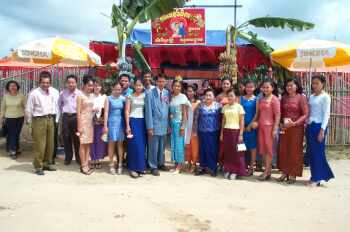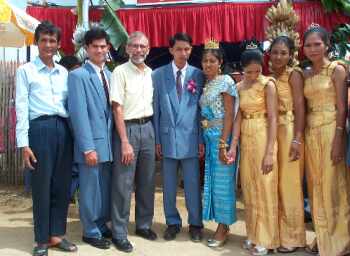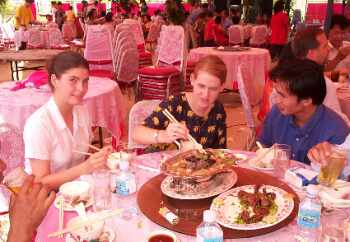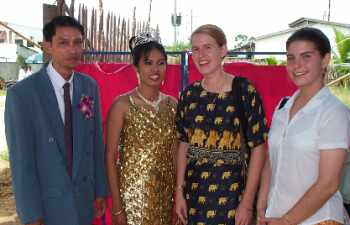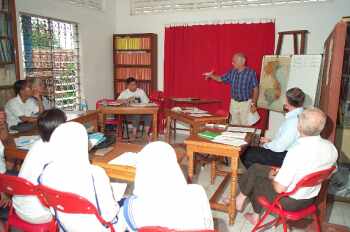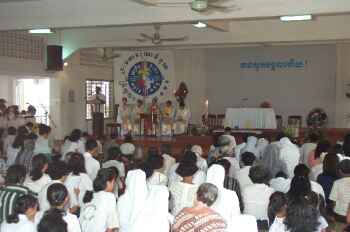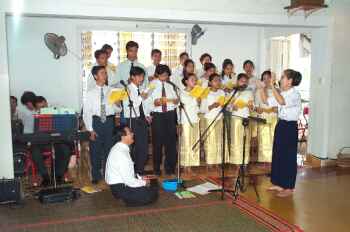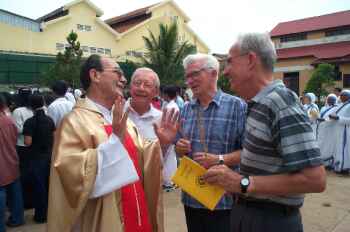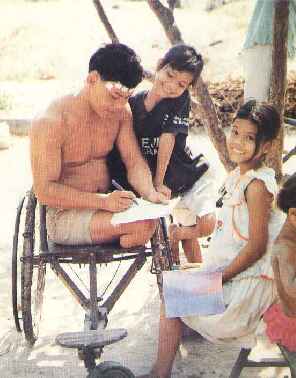|
How to Sleep
- You must wake up before sunrise or you are lazy.
- Sleeping places in the home are determined according to status. (Cambodian families often live in one or two rooms, and everyone sleeps on the same bed, a large slatted wooden platform about eight- or ten-feet square. The parents sleep at the "head" end and the youngest children sleep at the "foot.")
How to Walk
- Tell people where you are going and when you are coming back. (This is important to show respect to others and to keep them from being embarrassed if someone asks and they don't know where you are.)
- If someone of higher status is passing you, bend lower (from the waist) than that person.
- Don't make sounds with your skirt when you walk.
- Don't wear shoes or hats when you enter a house or temple.
- Close doors softly when you go through them.
- When you meet someone on the street, ask where they are going.
How to Stand
- Stand with your arms crossed at the waist. (Arms at the side means you are signaling that you are strong. Hands on the hips or arms behind your back or across the chest means you are rich, powerful, threatening, or disrespectful of other people.)
How to Sit
- Sit with your legs straight down. (Crossing legs shows disrespect.)
- Never put your feet on a table or show the soles of your feet to others.
- Men can sit on the floor in the lotus position while eating.
- Women must sit on the floor with legs aside.
How to Speak
- You must speak softly and gently.
- Show feelings only at home.
- Children have no right to speak unless spoken to.
- A guest is polite and doesn't talk unless spoken to.
- Let others talk more than you.
- There should be limited talking at meals. Speak only if spoken to.
- If you speak with anger or emotion or express feelings, you will not be respected. You are behaving like an immature and uneducated child.
- Patience is a virtue. (Parents make a comparison between a gasoline fire which ignites quickly and burns to nothing, and a charcoal fire which is difficult to start but cannot easily be extinguished and becomes more intense.)
- Do not make aggressive movements or gestures--such as making a fist, pounding the table, or throwing something--while speaking.
- Moderated feelings are best, i.e., those that are neither very happy or very angry or sad.
- Giving criticism or discussing an individual's problems must not be done in public. (That person will lose face, want revenge, and will be unable to accept your idea.) If you must give criticism, do so in private and indirectly. Talk around the issue, ask for information about the issue, and then let the individual reach her own conclusion in her own time and way.
How to Eat
- Men can eat a lot but must not eat fast.
- Women can eat only a small amount.
- Take food only when asked or directed to.
- Use the communal spoon. Not using it indicates you are insincere or not part of the group.
- People of high rank do not expect to have to get their own food (especially at a buffet). They are often seated in a private or special place and served by others to show status and respect.
- All guests must be served water or another drink even if they come for only a short visit. Give a drink rather than ask what they want which is impolite. If asked, they are obligated to choose the least expensive drink.
- If guests come during a meal, they must be invited to eat.
How to Greet
- Offer a traditional greeting with hands in front of face, palms together, in prayer-like fashion.
- Men can shake hands with men.
- Men should not shake hands with Khmer women unless they offer their hand.
- Men should not hug, kiss, or touch the body of a Khmer woman while greeting her. (She will lose respect and feel embarrassed.)
- Men should not look women directly in the eye. (They may become confused, feel uncomfortable, nervous, shy, and not respected.)
- Men should not give "strong" visual attention to other men.
How to Dress
- Formality is very important for respect in the office and at important occasions, when teaching, or when being welcomed as a guest.
- Men wear long-sleeve shirts, long pants, and shoes. No T-shirts and sandals.
- Women should avoid skirts above the knees and sleeveless or low-cut blouses.
- Shorts are not appropriate in public or when a guest.
- The goal in dressing is to blend in with others, not to stand out.
- Men's hair should be short.
How to Work
- Maintaining proper relationships in the office takes priority over the work.
- Proper behavior is more important than work performance.
- You will get honor if you show respect and politeness to those of higher status or power.
- Your performance will be evaluated based on allegiance to those in power.
- You will be rewarded with money or power or job security if you give respect and allegiance to your superiors.
- It is better to agree than to disagree, especially if the other person has a higher status.
- It is the responsibility of those in power to make decisions.
[The End]
|

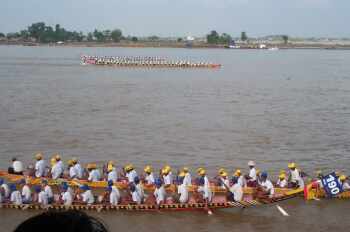
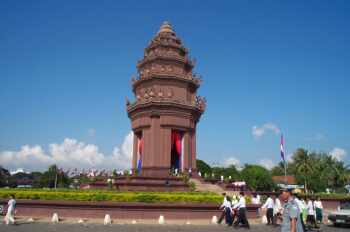
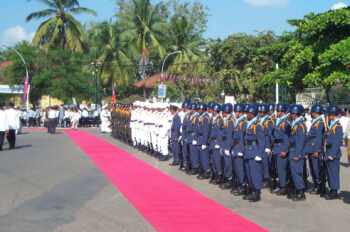
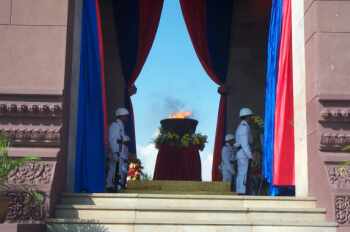
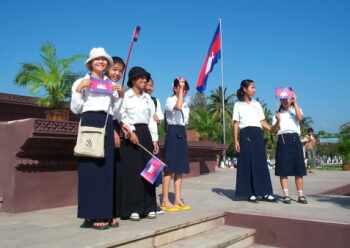
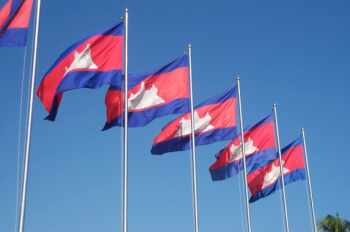
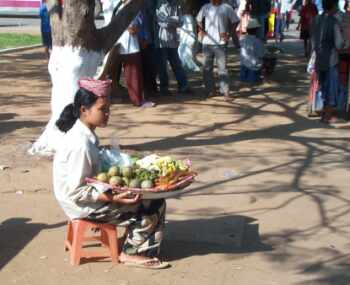
 Kadaka, one of the teachers of the Maryknoll people at the Khmer School of Language, was married to Chantha on 28 October, and we were anxious to go because none of us had yet attended a Khmer wedding. Actually, we were invited to the reception rather than to the wedding because the wedding begins at 6:00 AM or 7:00 AM with various traditional rituals, such as a procession to the bride's house, ceremonies with the parents, etc., and only the families are present for that. We were invited to the last stage, a large banquet. I was surprised how the Khmer wedding ceremony is almost identical to those I experienced with the Chinese in Hong Kong.
Kadaka, one of the teachers of the Maryknoll people at the Khmer School of Language, was married to Chantha on 28 October, and we were anxious to go because none of us had yet attended a Khmer wedding. Actually, we were invited to the reception rather than to the wedding because the wedding begins at 6:00 AM or 7:00 AM with various traditional rituals, such as a procession to the bride's house, ceremonies with the parents, etc., and only the families are present for that. We were invited to the last stage, a large banquet. I was surprised how the Khmer wedding ceremony is almost identical to those I experienced with the Chinese in Hong Kong.
